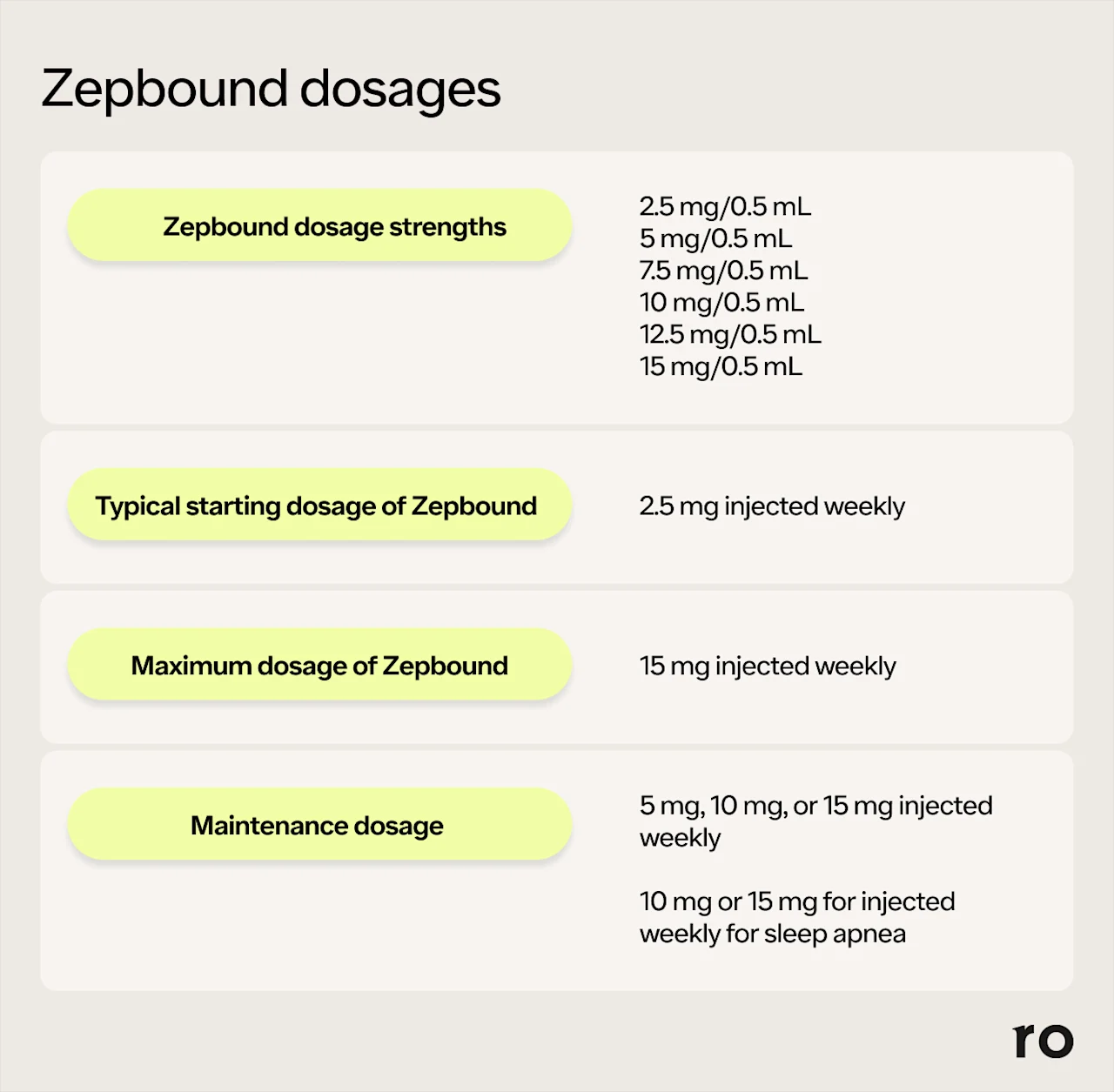Key takeaways
Zepbound (tirzepatide) is a prescription injectable medication that’s FDA-approved for weight loss and management in people with obesity or overweight and at least one weight-related health condition. It’s also approved to treat obstructive sleep apnea in adults with obesity.
It works by mimicking the natural gut hormones GLP-1 and GIP to regulate appetite, digestion, and blood sugar to promote weight loss.
Monthly costs vary depending on dosage, insurance, pharmacy, and other factors, but you can get Zepbound vials for as low as $299 per month if you pay with cash.
Here's what we'll cover
Key takeaways
Zepbound (tirzepatide) is a prescription injectable medication that’s FDA-approved for weight loss and management in people with obesity or overweight and at least one weight-related health condition. It’s also approved to treat obstructive sleep apnea in adults with obesity.
It works by mimicking the natural gut hormones GLP-1 and GIP to regulate appetite, digestion, and blood sugar to promote weight loss.
Monthly costs vary depending on dosage, insurance, pharmacy, and other factors, but you can get Zepbound vials for as low as $299 per month if you pay with cash.
If you’re on a weight loss journey, you’ve likely heard of Ozempic and Wegovy. But there’s also a newer weight loss drug in town. Zepbound, the brand name of tirzepatide, is a medication that was previously only marketed under the brand name Mounjaro.
Zepbound is approved by the US Food and Drug Administration (FDA) for weight loss and chronic weight management in people with obesity or overweight and at least one weight-related health condition. It’s also approved to treat obstructive sleep apnea in adults with obesity. But those are just the basics.
Ahead, we break down everything you need to know about Zepbound, including what it is, how it works, and what makes it unique.
What is Zepbound?
Zepbound is an FDA-approved injectable prescription medication for weight loss in people with obesity or overweight and a weight-related health condition. It’s also approved to treat moderate-to-severe obstructive sleep apnea in adults with obesity. It comes in as prefilled pens and vials.
In clinical trials, Zepbound led to an average weight loss of 15%–21% within a year and a half, when used in combination with diet and exercise. In that time period, participants taking Zepbound lost 35–52 pounds. In comparison, those taking a placebo lost just five pounds on average.
Like other weight loss medications, it has experienced shortages on and off since hitting the market. As of publication, however, all dosage strengths of Zepbound are available, according to the Drug Shortages database managed by the FDA. Keep in mind, though, that availability can (and often does) vary across pharmacies, potentially affecting patients’ ability to fill their prescriptions even if the drug is in stock per the FDA.
How do you take Zepbound?
Each box of Zepbound contains four single-dose prescription pens that come prefilled with a needle attached. Like the pens, each Zepbound vial contains just one dose of the drug. But you must use a separate needle and syringe to draw out the medication yourself.
To take Zepbound, you inject the medication just under the skin of your abdomen, thigh, or upper arm once a week. You should rotate your injection site each time you inject.
The medication is available in six dosage strengths. Zepbound vials and pens are available in all six dosage strengths, including 12.5 mg and 15 mg.
Typically, healthcare providers recommend starting with 2.5 mg of Zepbound weekly before increasing the dosage every four weeks until a maintenance dosage of 5 mg, 10 mg, or 15 mg is reached.

How does Zepbound work?
Zepbound works similarly to other injectable weight loss medications, like Wegovy and Ozempic, but there’s one big difference. Wegovy and Ozempic are known as GLP-1 agonists (glucagon-like peptide 1) because they target the receptor of GLP-1, a gut hormone produced naturally in the body. GLP-1 plays a role in regulating both appetite and blood sugar levels in response to food.
GLP-1 agonists help with weight loss by slowing down digestion. Specifically, they keep food in your stomach longer, so you feel full sooner and stop eating. GLP-1 drugs further reduce appetite by sending signals to your brain that you are full. Some research suggests that these medications may even affect your brain’s reward system regarding food and may reduce your cravings for certain foods.
What sets Zepbound apart from the rest?
Zepbound is particularly effective for weight loss because it targets the GLP-1 receptor and another receptor for glucose-dependent insulinotropic polypeptide (GIP). This distinction may explain Zepbound’s more pronounced effects on weight loss and metabolism.
In the body, GLP-1 and GIP only remain active for a few minutes. But tirzepatide, the active ingredient in Zepbound, remains active for days, amplifying the effects of GLP-1 and GIP. This also means people only have to inject Zepbound once a week (a welcome alternative to daily injections).
GIP (glucose-dependent insulinotropic polypeptide) is a hormone released by the gut when you eat. The hormone regulates your blood sugar levels, particularly when you consume carbohydrates and fats. In this process, GIP helps your body absorb and use sugar by telling your pancreas to release insulin. It also prevents the liver from producing too much sugar.
While Zepbound may increase weight loss by regulating blood sugar, it’s important to understand that the medication alone is not enough to produce significant weight loss results. To be effective, Zepbound should be used along with a healthy diet and consistent exercise.
How effective is Zepbound?
Weight loss results appear to be dose-dependent with Zepbound. People taking higher dosage strengths lose more weight. For example, in clinical trials, people taking:
5 mg of Zepbound lost 15% of their body weight (35.5 pounds), on average
10 mg of Zepbound lost 19.5% of their body weight (49 pounds), on average
15 mg of Zepbound lost 20.9% of their body weight (52 pounds), on average
In clinical trials, 85%–91% of people taking Zepbound lost at least 5% of their body weight.
Over half of the people taking 10 mg or 15 mg lost at least 20% of their body weight.
Among those taking the highest 15 mg dosage of Zepbound, one in three lost 25% of their body weight.
Overall, people shaved an average of 5.5–7.3 inches off their waistlines, reducing their body fat by about 34%.
That data makes Zepbound the most effective weight loss medication on the market. It leads to more weight loss, on average, than either Wegovy, Saxenda, or Ozempic, similar injectable medications in a similar class as Zepbound.
In addition to weight loss, clinical participants saw other health benefits in connection with the weight loss. Participants’ blood pressure and cholesterol also improved on Zepbound. Nearly all (95%) of those who had prediabetes at the beginning of the study had normal blood sugar levels by the end of the trial.
Zepbound vs. Mounjaro
Mounjaro and Zepbound are two brand-name versions of the same active ingredient, tirzepatide. However, Zepbound and Mounjaro are FDA-approved to treat different conditions.
Mounjaro came first and is FDA-approved:
To treat type 2 diabetes in adults by controlling their blood sugar levels
Zepbound is FDA-approved:
For chronic weight management in adults with obesity or overweight and a weight-related medical condition
To treat obstructive sleep apnea in adults with obesity
Prior to Zepbound’s approval, healthcare providers may have been more likely to prescribe Mounjaro off-label for weight loss to patients with overweight or obesity who may not have had type 2 diabetes. Both Mounjaro and Zepbound should be used in combination with lifestyle changes like diet and exercise.
Who is eligible for Zepbound?
Zepbound is FDA-approved for weight loss and chronic weight management in adults with obesity or overweight.
Before prescribing Zepbound, your healthcare provider will ask you about your personal and family medical history and a list of any medications or supplements you are currently taking. This is to ensure Zepbound is safe for you, as people with certain health conditions may be at increased risk when taking Zepbound.
For example, Zepbound should not be used by people who are pregnant, breastfeeding, or planning to be anytime soon. Zepbound is also contraindicated in people with severe gastrointestinal disease.
Also, animal studies have found that tirzepatide, the active ingredient in Zepbound, can increase the risk of thyroid tumors in rats. While it is not known if Zepbound has the same effect in humans, people who have a personal or family history of certain thyroid cancers, including medullary thyroid carcinoma and Multiple Endocrine Neoplasia syndrome type 2 (MEN 2), should not take Zepbound.
Zepbound side effects
The most common side effects of Zepbound include:
Nausea
Diarrhea
Vomiting
Abdominal pain
Indigestion
Injection site reactions (such as rash)
Belching
Gastroesophageal reflux disease (GERD)
Many of these side effects — particularly the digestive effects like nausea, diarrhea, and constipation — are common to medications like Zepbound, Mounjaro, Ozempic, Wegovy, and others. Typically, gastrointestinal side effects range from mild to moderate and are most common when increasing your dose.
For many people, Zepbound is a safe and effective medication for weight loss. In rare cases, however, it may cause serious side effects. These include:
Severe gastrointestinal disease
Acute kidney injury
Acute gallbladder disease
Acute pancreatitis
Allergic reaction to Zepbound
Hypoglycemia (low blood sugar)
Diabetic retinopathy (vision loss or damage in people with type 2 diabetes)
Depression or suicidal thoughts
People with type 2 diabetes or a history of kidney or gallbladder problems may be at increased risk of experiencing these side effects, so be sure to tell your healthcare provider about any underlying health conditions prior to starting Zepbound. They can adjust your dosages of insulin to avoid hypoglycemia or recommend other safety measures to avoid potential side effects.
How much does Zepbound cost?
The list price of Zepbound is $1,086.37 per month, which is lower than that of Wegovy ($1,349.02 per month). The actual cost of Zepbound you pay may be higher or lower, depending on your insurance coverage and the pharmacy you use.
Another factor that can influence the price? The form of the drug. Zepbound vials cost much less, though they can only be paid in cash. Here’s the pricing:
$299/month: 2.5 mg dose
$399/month: 5 mg dose
$449/month (with manufacturer offer): 7.5 mg, 10 mg, 12.5 mg, 15 mg doses
The actual cost of Zepbound you pay may be higher or lower, depending on your insurance coverage and the pharmacy you use.
Eli Lilly offers a Zepbound Savings Card for people with commercial insurance. This coupon can bring the cost of a one- or three-month supply of Zepbound down to as low as $25 for those with coverage for Zepbound. For people with commercial insurance coverage that doesn’t include Zepbound, the manufacturer’s offering can provide up to $469 off one-month of the medication. Medicare notably does not provide coverage for weight loss medications, although that may change in the future.
If you struggle to lose weight with diet and exercise alone, Zepbound may be a good option for you. To learn more about Zepbound, make an appointment with your healthcare provider or connect with a telehealth provider through Ro, which offers a comprehensive, 12-month weight loss program that includes:
Metabolic testing (if needed)
A personalized treatment plan
1:1 health coaching
A step-by-step curriculum
Ongoing support from your provider
Insurance concierge services to help you get coverage
Your provider will help you develop a safe and effective weight loss plan.
Bottom line
Zepbound is one of the most effective prescription medications currently available for weight loss — and it’s backed by strong clinical results. It works by targeting two key gut hormone receptors to help regulate appetite, improve metabolism, and support sustained weight loss when paired with lifestyle changes. While it may not be right for everyone, Zepbound offers a powerful option for people struggling with obesity or overweight.
Zepbound is FDA-approved for weight loss in adults with obesity or overweight and for obstructive sleep apnea in adults with obesity.
In clinical trials, people lost an average of 15%–21% of their body weight — up to 52 pounds — depending on dosage.
Zepbound works differently than Wegovy and Ozempic by targeting both GLP-1 and GIP receptors, which may enhance its effectiveness.
Side effects are common, especially gastrointestinal ones, but most are mild to moderate and tend to improve over time.
Zepbound costs around $1,086 per month, though savings cards and vials can significantly lower out-of-pocket costs depending on insurance coverage. Zepbound vials, for example, can cost as low as $299 per month but are only available for cash pay.
DISCLAIMER
If you have any medical questions or concerns, please talk to your healthcare provider. The articles on Health Guide are underpinned by peer-reviewed research and information drawn from medical societies and governmental agencies. However, they are not a substitute for professional medical advice, diagnosis, or treatment.
Ozempic Important Safety Information: Read more about serious warnings and safety info.
Wegovy Important Safety Information: Read more about serious warnings and safety info.
Zepbound Important Safety Information: Read more about serious warnings and safety info.
Mounjaro Important Safety Information: Read more about serious warnings and safety info.
Saxenda Important Safety Information: Read more about serious warnings and safety info.
GLP-1 Important Safety Information: Read more about serious warnings and safety info.
References
Chavda, V. P., Ajabiya, J., Teli, D., et al. (2022). Tirzepatide, a New Era of Dual-Targeted Treatment for Diabetes and Obesity: A Mini-Review. Molecules (Basel, Switzerland), 27(13), 4315. doi:10.3390/molecules27134315. Retrieved from https://www.ncbi.nlm.nih.gov/pmc/articles/PMC9268041/
Eli Lilly-a. (2023). FDA Approves Lilly's Zepbound™ (tirzepatide) for Chronic Weight Management, a Powerful New Option for the Treatment of Obesity or Overweight with Weight-Related Medical Problems. Lilly Investors. Retrieved from https://investor.lilly.com/news-releases/news-release-details/fda-approves-lillys-zepboundtm-tirzepatide-chronic-weight
Eli Lilly-b. (2023). Zepbound (tirzepatide) Injection for Adults with Obesity or Excess Weight. Retrieved from https://www.zepbound.lilly.com/
Forzano, I., Varzideh, F., Avvisato, R., et al. (2022). Tirzepatide: A Systematic Update. International Journal of Molecular Sciences, 23(23), 14631. doi:10.3390/ijms232314631. Retrieved from https://www.ncbi.nlm.nih.gov/pmc/articles/PMC9741068/
Jastreboff, A. M., Aronne, L. J., Ahmad, N. N., et al. (2022). Tirzepatide Once Weekly for the Treatment of Obesity. The New England Journal of Medicine, 387(3), 205–216. doi:10.1056/NEJMoa2206038. Retrieved from https://www.nejm.org/doi/10.1056/NEJMoa2206038
Liu, L., Chen, J., Wang, L., et al. (2022). Association between different GLP-1 receptor agonists and gastrointestinal adverse reactions: A real-world disproportionality study based on FDA adverse event reporting system database. Frontiers in Endocrinology, 13, 1043789. doi:10.3389/fendo.2022.1043789. Retrieved from https://pubmed.ncbi.nlm.nih.gov/36568085/
Maciejewski, M. L., Arterburn, D. E., Van Scoyoc, L., et al. (2016). Bariatric Surgery and Long-term Durability of Weight Loss. JAMA Surgery, 151(11), 1046–1055. doi:10.1001/jamasurg.2016.2317. Retrieved from https://www.ncbi.nlm.nih.gov/pmc/articles/PMC5112115/
Min, T. & Bain, S. C. (2021). The Role of Tirzepatide, Dual GIP and GLP-1 Receptor Agonist, in the Management of Type 2 Diabetes: The SURPASS Clinical Trials. Diabetes Therapy: Research, Treatment and Education of Diabetes and Related Disorders, 12(1), 143–157. doi:10.1007/s13300-020-00981-0. Retrieved from https://www.ncbi.nlm.nih.gov/pmc/articles/PMC7843845/
Nauck, M. A. & D'Alessio, D. A. (2022). Tirzepatide, a dual GIP/GLP-1 receptor co-agonist for the treatment of type 2 diabetes with unmatched effectiveness regarding glycaemic control and body weight reduction. Cardiovascular Diabetology, 21(1), 169. doi:10.1186/s12933-022-01604-7. Retrieved from https://www.ncbi.nlm.nih.gov/pmc/articles/PMC9438179/
Ryan, D. H. & Yockey, S. R. (2017). Weight Loss and Improvement in Comorbidity: Differences at 5%, 10%, 15%, and Over. Current Obesity Reports, 6(2), 187–194. doi:10.1007/s13679-017-0262-y. Retrieved from https://www.ncbi.nlm.nih.gov/pmc/articles/PMC5497590/
Sinha, R., Papamargaritis, D., Sargeant, J. A., et al. (2023). Efficacy and Safety of Tirzepatide in Type 2 Diabetes and Obesity Management. Journal of Obesity & Metabolic Syndrome, 32(1), 25–45. doi:10.7570/jomes22067. Retrieved from https://www.ncbi.nlm.nih.gov/pmc/articles/PMC10088547/
U.S. Centers for Medicare & Medicaid Services. (n.d.). National Coverage Determination (NCD): Treatment of Obesity. Retrieved from https://www.cms.gov/medicare-coverage-database/view/ncd.aspx?ncdid=38&ncdver=3&
U.S. Food & Drug Administration (FDA). (2023). FDA News Release: FDA Approves New Medication for Chronic Weight Management. Retrieved from https://www.fda.gov/news-events/press-announcements/fda-approves-new-medication-chronic-weight-management
U.S. Food & Drug Administration (FDA). (2025). Highlights of Prescribing Information: Mounjaro (tirzepatide) Injection, for subcutaneous use. Retrieved from https://www.accessdata.fda.gov/drugsatfda_docs/label/2025/217806s031lbl.pdf
U.S. Food & Drug Administration (FDA). (2025). Highlights of Prescribing Information: Zepbound (tirzepatide) Injection, for subcutaneous use. Retrieved from https://www.accessdata.fda.gov/drugsatfda_docs/label/2025/217806s031lbl.pdf
Xie, Z., Yang, S., Deng, W., et al. (2022). Efficacy and Safety of Liraglutide and Semaglutide on Weight Loss in People with Obesity or Overweight: A Systematic Review. Clinical Epidemiology, 14, 1463–1476. doi: 10.2147/CLEP.S391819. Retrieved from https://www.ncbi.nlm.nih.gov/pmc/articles/PMC9738168/














